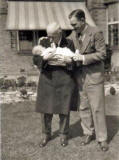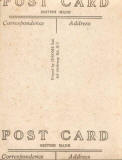|
Col. Bertram Gale and Jerome's London Studios |
|
Recollections 1. Nigel Price Oxford, England |
|
Thank you to Nigel Price of Oxford for sending me the following message. Nigel's mother, Nancye Freeman, was step-daughter of Col. Bertram Gale, who was involved with Jeromes for many years.. Nigel wrote: |
|
Col. Bertram Gale "My grandfather, Col. Bertram Gale, was what we would now call a 'professional investor'' in Jeromes. He was a very wealthy man, spending part of the year in London where he owned a complete floor of Kingston House overlooking Hyde Park. He held a number of directorships." |
|
Mayfair Studio, London "I know that Col. Gale was very interested in Jeromes and had an office there, I think in Jermyn Street. I can remember having my photograph taken there and being shown the wonders of the 'back stage', the dark rooms and large collection of cameras that I recall my grandfather saying that he had acquired over the years. Whether he was a shareholder/director/owner of Jerome, Mayfair, or whether his interest ranged over all the country-wide branches, I cannot say. I got the impression that, being a camera buff, Jerome enabled him to combine an investment with one of his hobbies. |
|
Debutante "I would guess that Col. Gale had an interest in Jerome for a long time as I recall photos of my mother (his daughter) dressed up to the nines before being presented at Buckingham Palace the year she 'came out' as a debutante, and of her as a bride, all of which bore the imprimateur of Jerome. |
|
Jerome Film Nigel writes: "Jerome sold their own film stock. I can remember using a box camera and I used to load it with Jerome film - the old 120 type mounted on a wooden shafted reel. I seem to recall the boxes the film came in, sealed in black-backed silver paper, were dark red with Jerome written in large letters on all four sides, the film type being shown at the box ends." |
|
Nigel Price, Oxford, England; June 27 + July 14, 2006 |
|
Recollections 2. Nigel Price Oxford, England |
|
Thank you to Nigel Price, for providing these Jerome photographs Nigel wrote: |
|
Jerome Photos "This picture shows my father and my grandfather, Sir William Price, with a baby who I have to presume is me." "The Jerome postcard below is of my uncle, Paddy Freeman, in Cadet Midshipman's uniform. He appears to have been about 12 - 14 years old. He went to Dartmouth Naval College as did all the boys in our family. I would guess that the photo must have been taken in the 1920s, perhaps hinting that my father had been associated with Jerome at the time. Please click on the images above to enlarge them and read more about them. |
|
Nigel Price, Oxford, England; July 14, 2006. |
|
Recollections 3. Dave Durham |
|
Thank you to Dave Durham for writing about the time when he worked for one of the Jerome studios in London. The EdinPhoto web site covers photography in Edinburgh (rather than London), but I've included these London recollections here because there were Jerome studios throughout Britain. Some of the practices and equipment remembered by Dave in London might be similar to what was found found at Jerome studios in Edinburgh and elsewhere. Dave wrote: |
|
Saturday Boy - 1955 "As a 6th former I started work In September 1955 as a 'Saturday Boy' at the Jerome Studio, 121 High Street North, East Ham, (now part of Newham), London E6 for 15/- (75p) a day !" Most of my time, at first, was spent in the workshop washing and drying prints and negs. I quickly moved on to dry mounting some of the large prints. Gradually, I learned all the workshop tasks, including retouching. As a keen amateur photographer with my own home darkroom / laboratory (the cellar!) I was 'tried out' in the darkroom. I stood in at luchtimes for the printer." |
|
London Branches "At busy times, I would be invited to come in to help out (and be paid). I was to work during school holidays at East Ham and at two of the remaining three London branches: - At Kilburn branch, I worked as holiday relief printer. - At the flagship Oxford Street branch, I worked in the workshop and studio darkroom as a loader and marker-upper. Brixton was the other London branch that was still open. Technical difficulties were mentioned in this branch of photographing dark-skinned people using orthochrome card I believe that Brixton branch was to close before the company ceased trading in the mid 1960s when it was taken over by Bennetts (?) who were, in turn, taken over by Dixons." |
|
Materials "At that time, Jerome used Ilford Bromide Paper, grade 1 (soft) for prints and Ilford orthochromatic negative card. Johnson of Hendon provided the chemicals. The Victorian pedestal camera had a sliding back to take three pictures on one negative card. These were marked on the back with a chinagraph pencil with an order number and a code for the printer. Jerome spools were an orthochromatic paper with a probable speed of 50ASA. Pre-war, they were certainly being developed and printed in a separate darkroom in the East Ham branch." |
|
Moving On "When I made it known, in the early summer of 1958, that I was intending to enter teacher training, I was offered a job at Jerome's Oxford Street branch, where I would be part of a team experimenting with colour negative card to introduce a colour option throughout the remaining branches. I chose teaching !" |
|
Dave Durham; July 27, 2010 |
|
Recollections 4. Dave Durham |
|
Thank you to Dave Durham for writing again to tell me more about the time when he worked in Jerome studios in London. The EdinPhoto web site covers photography in Edinburgh (rather than London), but I've included these London recollections here because there were Jerome studios throughout Britain. Some of the practices and equipment remembered by Dave in London might be similar to what was found found at Jerome studios in Edinburgh and elsewhere. Dave wrote: |
|
Studio Camera and Stand "I can provide information on the Jerome studio camera we had at East Ham where I worked on Saturdays and school holidays from 1955-58. This apparatus appeared to be Victorian and was, even by then, a museum piece! It was a very solid mahogany structure, mounted on a thick single-post stand with a wide solid ornate base that had three short legs with a castor on each. It was bottom- heavy and very stable." |
|
Lens and Shutter "The lens was, I think, a good 8" anastigmat with a variable iris. For the negative size, this lens was effectively a short telephoto lens and an excellent choice to give a more natural perspective for portraiture. Having positioned the camera, there was a hinged lift-up ground glass focussing screen, used together with an 'over the head' black cloth for the operator to focus the camera by moving the lens board on a rack and pinion mechanism. The camera had a pneumatic bulb shutter which just opened and shut. Exposure time was based on the operators knowledge and skill - i.e. a calculated guess." |
|
Three Exposures "Instead of the usual plate back, there were long runners which held the wooden 'plate' holder. This could be moved to three different notched positions to allow three exposures on orthochromatic negative card (made by Ilford when I worked there). All pictures were upright. There was no facility on that camera to turn the plate round to take a view. Once all three negatives had been exposed and the dark slide inserted, a clip on the holder held a copy of the order slip, giving three order numbers and codes for the print orders" The camera would be focussed, the screen lifted and the holder moved to an unexposed frame. The lens, would generally be stopped down to f8." |
|
Studio Lighting "At this point the main studio lights would be turned on. At East Ham where I worked there were four big bulbs (500w). These were in large shades and faced into large white screens fixed to the ceiling. These reflected their light into the studio. There were no shadows from this brilliant diffuse light. It was very flattering for the ladies!. The exposure was about 1 - 2 seconds judged by the operator. Squeeze to open, release to close. The idea was one exposure per order. After the exposure the hot studio lights would be immediately turned off. At Christmas the operators might take in excess of 100 sitters during the day. That's about 4 minutes per sitter. |
|
Retouching "Wriggly babies were the worst. Any slight movement could often be 'corrected' by the retoucher who, using a fine craft knife, a set of finely pointed pencils. Johnson's Retouching Medium would work on the card negative rather than the prints." |
|
Orthochromatic Materials "Orthochromatic materials are not very sensitive to red, so the negative cards could then be marked up on the back with the order details, using a chinagraph pencil, and fresh unexposed cards fitted. This was done by the light of a dim red safelight in the cupboard that served as the studio darkroom." |
|
Processing "The marked cards were placed into a black wooden box whose lid was held firmly closed by a broad black elastic strap. This went to the main workshop darkroom to be opened for developing under red light. The negative cards used were about 110mm x 250mm (about 4 x 10 inches). The dried processed cards were date stamped on the back before being retouched." |
|
Scenery "The studio had various curtains and painted screens to use for backgrounds. There was also a bench for sitting on, or for arranging babies. There were a few toys to help with posing young children." |
|
The Photographer "Generally the manager of the shop was the operator, but at quiet times other staff, including myself, were trained up to do this and other tasks." |
|
Equipment "The workroom and darkroom held equipment of similar vintage. Working in these rooms would certainly not meet present day health and safety requirements." |
|
Dave Durham; July 27, 2010 |
|
JEROME PAGES |



